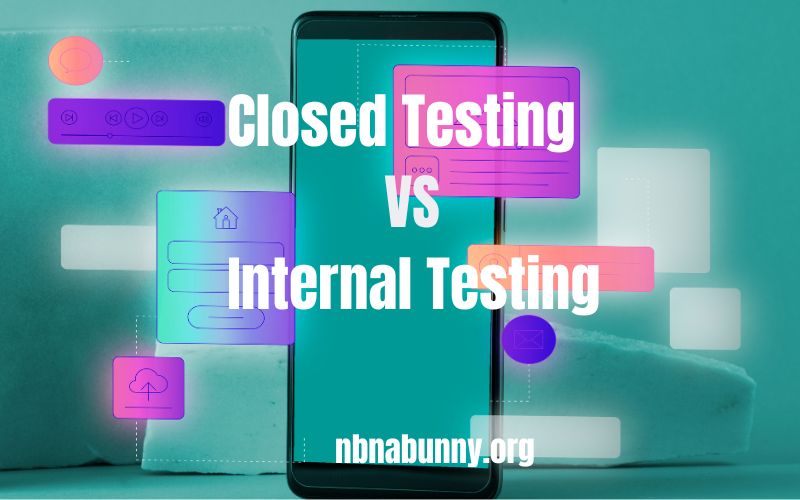Testing is one of the most crucial stages in app development. Before your app reaches its final users, it’s essential to ensure that it functions perfectly and meets the expectations of its audience. Two commonly used testing approaches are closed testing vs internal testing. While both methods aim to improve the app’s performance and user experience, they serve different purposes and audiences. In this blog, we will explore the differences, benefits, and best practices of closed testing and internal testing, helping you choose the best method for your project.
Key Points:
- Closed testing involves a small group of external testers.
- Internal testing is conducted by the development team and stakeholders.
- Both methods focus on identifying bugs and improving the app’s quality.
What Is Closed Testing?
Closed testing is a type of app testing where the app is shared with a limited group of external testers. These testers are often selected based on specific criteria, such as demographics, device types, or expertise. The main goal of closed testing is to gather feedback from real users in a controlled environment. This ensures that the app is polished and ready for public release.
Benefits of Closed Testing
- Diverse User Feedback: Closed testing allows you to collect feedback from users who represent your target audience. For example, if you’re developing a fitness app, inviting gym-goers or fitness enthusiasts can provide valuable insights.
- Bug Identification: Testers can spot hidden bugs or issues that the development team may have overlooked. For instance, a tester might report that a specific feature doesn’t work on older devices.
- Improved User Experience: Feedback from external testers can help you refine the app’s design and functionality, ensuring a seamless experience for end users.
Note: Always select testers who match your target audience to get the most relevant feedback.
What Is Internal Testing?
Internal testing is conducted within the development team or organization. This type of testing involves developers, QA engineers, and sometimes stakeholders. The primary objective of internal testing is to identify technical issues and ensure the app meets its functional requirements before sharing it with external users.
Benefits of Internal Testing
- Early Issue Detection: Developers and QA teams can catch bugs early in the development process, saving time and resources.
- Confidentiality: Since internal testing is limited to the organization, it minimizes the risk of leaks or unauthorized access to the app.
- Streamlined Communication: Testing within the team allows for faster feedback and quicker implementation of fixes.
Reminder: Internal testing should focus on technical aspects, while closed testing should address real-world user scenarios.
How Are Closed Testing and Internal Testing Different?
Although both closed testing and internal testing aim to improve the quality of an app, they differ in several key aspects. Here’s a detailed comparison:
| Feature | Closed Testing | Internal Testing |
| Audience | External testers (target audience) | Internal team (developers, QA) |
| Purpose | User feedback and real-world testing | Identifying technical issues |
| Confidentiality | Moderate | High |
| Feedback Type | User-focused (design, usability) | Technical and functional |
| Cost | Moderate | Low |
Which Testing Method Should You Choose?
The choice between closed testing and internal testing depends on your app’s development stage and testing goals. Below are some scenarios to help you decide:
When to Use Closed Testing
- Before Public Launch: Closed testing is ideal for gathering real-user feedback before launching the app.
- Targeted Features: If you want to test specific features with a niche audience, closed testing is the way to go.
- Performance Testing: External testers can provide insights on how the app performs on different devices and network conditions.
When to Use Internal Testing
- Early Development: Internal testing is crucial during the initial development stages to fix bugs and refine functionality.
- Confidential Projects: For sensitive apps, internal testing ensures confidentiality and security.
- Technical Validation: Use internal testing to validate the app’s technical aspects, such as code efficiency and API integrations.
Can You Combine Both Testing Methods?
Yes, combining closed testing and internal testing can provide comprehensive results. For example, you can start with internal testing to resolve technical issues, followed by closed testing to gather real-user feedback. This approach ensures that the app is both technically sound and user-friendly.
Table: Benefits of Combining Both Methods
| Benefit | Example |
| Comprehensive Testing | Covers both technical and user aspects |
| Enhanced Quality | Ensures a polished and bug-free app |
| Reduced Risk | Minimizes post-launch issues |
Note: Combining both methods may require additional time and resources but yields better results.
Conclusion
Choosing the right testing method is critical for your app’s success. Closed testing focuses on real-world user scenarios, while internal testing addresses technical issues. Both methods have unique benefits and can complement each other when combined effectively. By understanding their differences and applications, you can create a testing strategy that ensures a flawless app launch. Remember, thorough testing is an investment in your app’s quality and user satisfaction.
FAQ’s About Closed Testing vs Internal Testing
- What is the main difference between closed testing and internal testing? Closed testing involves external users, while internal testing is conducted within the development team.
- Can I use both closed testing and internal testing for my app? Yes, combining both methods can provide comprehensive results and improve app quality.
- Who should participate in closed testing? Invite users who represent your app’s target audience for the most relevant feedback.
- When should I conduct internal testing? Internal testing is best during the early stages of development to identify and fix technical issues.
- Is closed testing expensive? Closed testing can be moderately expensive, but its benefits in gathering user feedback outweigh the costs.
